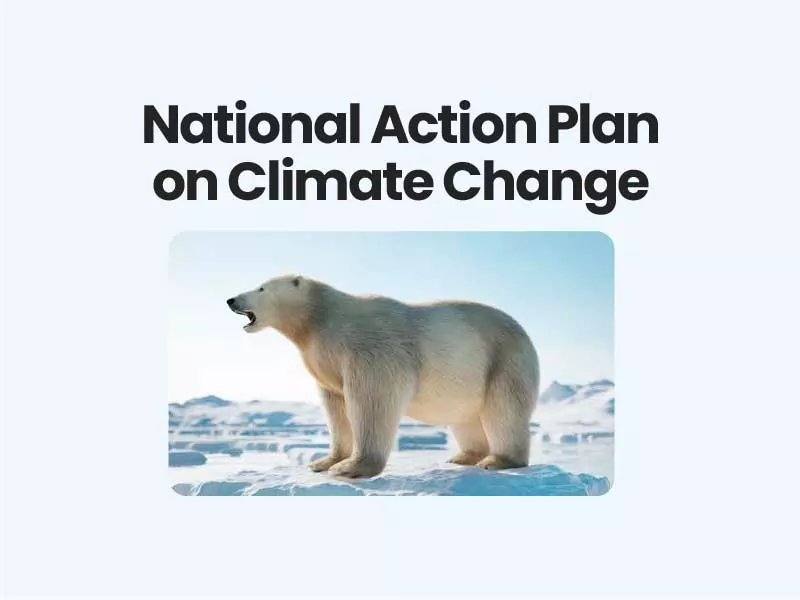Companion@360 → 7 Month programme to sharpen your writing skills → REGISTER NOW

National Action Plan on Climate Change (NAPCC)
The Action Plan was released on 30th June 2008. It effectively pulls together a number of the government’s existing national plans on water, renewable energy, energy efficiency agriculture and others – bundled with additional ones – into a set of eight missions.
The Prime Minister’s Council on Climate Change is in charge of the overall implementation of the plan. The plan document elaborates on a unique approach to reduce the stress of climate change and uses the poverty-growth linkage to make its point.
Emphasizing the overriding priority of maintaining high economic growth rates to raise living standards, the plan “identifies measures that promote development objectives while also yielding co-benefits for addressing climate change effectively.
”It says these national measures would be more successful with assistance from developed countries, and pledges that India’s per capita greenhouse gas emissions “will at no point exceed that of developed countries even as we pursue our development objectives.”
Plan in a Nutshell:
The guiding principles of the plan are:
- Inclusive and sustainable development strategy to protect the poor
- Qualitative change in the method through which the national growth objectives will be achieved i.e. by enhancing ecological sustainability leading to further mitigation
- Cost effective strategies for end use demand side management
- Deployment of appropriate technologies for extensive and accelerated adaptation, and mitigation of green house gases
- Innovative market, regulatory and voluntary mechanisms to promote Sustainable Development
- Implementation through linkages with civil society, local governments and public-private partnerships
- International cooperation, transfer of technology and funding
National Missions:
The core of the implementation of the Action plan are constituted by the following eight missions, that will be responsible for achieving the broad goals of adaptation and mitigation, as applicable.
- National Solar Mission: The NAPCC aims to promote the development and use of solar energy for power generation and other uses with the ultimate objective of making solar competitive with fossil-based energy options. The plan includes: Specific goals for increasing use of solar thermal technologies in urban areas, industry, and commercial establishments; a goal of increasing production of photo-voltaic to 1000 MW/year; and a goal of deploying at least 1000 MW of solar thermal power generation. Other objectives include the establishment of a solar research centre, increased international collaboration on technology development, strengthening of domestic manufacturing capacity, and increased government funding and international support.
- National Mission for Enhanced Energy Efficiency: Current initiatives are expected to yield savings of 10,000 MW by 2012. Building on the Energy Conservation Act 2001, the plan recommends: Mandating specific energy consumption decreases in large energy-consuming industries, with a system for companies to trade energy-savings certificates; Energy incentives, including reduced taxes on energy-efficient appliances; and Financing for public-private partnerships to reduce energy consumption through demand-side management programs in the municipal, buildings and agricultural sectors.
- National Mission on Sustainable Habitat: To promote energy efficiency as a core component of urban planning, the plan calls for: Extending the existing Energy Conservation Building Code; A greater emphasis on urban waste management and recycling, including power production from waste; Strengthening the enforcement of automotive fuel economy standards and using pricing measures to encourage the purchase of efficient vehicles; and Incentives for the use of public transportation.
- National Water Mission: With water scarcity projected to worsen as a result of climate change, the plan sets a goal of a 20% improvement in water use efficiency through pricing and other measures.
- National Mission for Sustaining the Himalayan Ecosystem: The plan aims to conserve biodiversity, forest cover, and other ecological values in the Himalayan region, where glaciers that are a major source of India’s water supply are projected to recede as a result of global warming.
- National Mission for a “Green India”: Goals include the afforestation of 6 million hectares of degraded forest lands and expanding forest cover from 23% to 33% of India’s territory.
- National Mission for Sustainable Agriculture: The plan aims to support climate adaptation in agriculture through the development of climate-resilient crops, expansion of weather insurance mechanisms, and agricultural practices.
- National Mission on Strategic Knowledge for Climate Change: To gain a better understanding of climate science, impacts and challenges, the plan envisions a new Climate Science Research Fund, improved climate modeling, and increased international collaboration. It also encourages private sector initiatives to develop adaptation and mitigation technologies through venture capital funds.
The NAPCC also describes other ongoing initiatives, including:
- Power Generation: The government is mandating the retirement of inefficient coal-fired power plants and supporting the research and development of IGCC and supercritical technologies.
- Renewable Energy: Under the Electricity Act 2003 and the National Tariff Policy 2006, the central and the state electricity regulatory commissions must purchase a certain percentage of grid-based power from renewable sources.
- Energy Efficiency: Under the Energy Conservation Act 2001, large energy consuming industries are required to undertake energy audits and an energy labeling program for appliances has been introduced.
Implementation
- Ministries with lead responsibility for each of the missions are directed to develop objectives, implementation strategies, timelines, and monitoring and evaluation criteria, to be submitted to the Prime Minister’s Council on Climate Change.
- The Council will also be responsible for periodically reviewing and reporting on each mission’s progress. To be able to quantify progress, appropriate indicators and methodologies will be developed to assess both avoided emissions and adaptation benefits.
Further, as on July 2015, around 27 States and 5 Union Territories have prepared State Action Plan on Climate Change (SAPCC) consistent with the objectives of NAPCC, focusing on the state specific issues relating to climate change and strategies to tackle them.
Read Also Humpback dolphins

